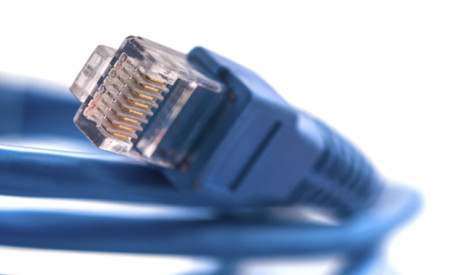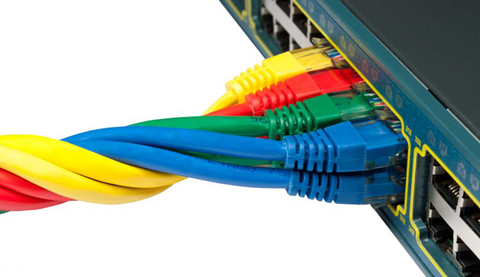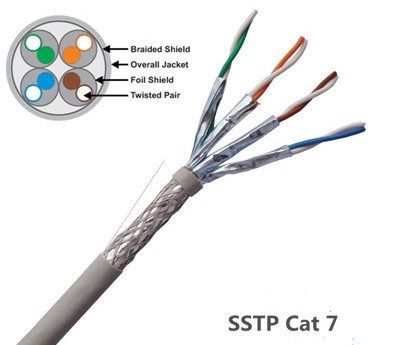Do You Know About Cat 8 Cable?
srijeda , 14.09.2016.Cat 5e or cat 6 cables now are the mainstream of the copper network solution, but optical technology are progressing to promote higher category copper cables for the increasingly heavy-loaded data center solution. Cat 8 cables lately has been much talked about, especially after the TIA category 8 cabling standard approved. Category 8 is regarded as the next-generation twisted-pair cabling specification for higher data rate, but it is still under development. Here is what we need to know about the basics of Cat 8 cabling.
Main Features of Category 8 Standard
Cat 8 cable is especially designed to support 25G or 40G Ethernet data rate with a link distance of up to 30 meters, which is sufficient for most switch-to-server connections for top-of-rack (ToR), middle-of-row (MoR) or end-of-row (EoR) topologies. In addition, category 8 cabling is fully backward compatible with category 6A cabling, including RJ45 connectivity, and supports all Category 6A applications such as 10GBASE-T for a distance of 100 meters.

Category 8 cabling and components are specified with transmission performance of up to 2 GHz (four times the bandwidth of Category 6 cabling and two times the bandwidth of category 7) with more stringent alien crosstalk requirements. Meeting these requirements requires a shielded cabling system (F/UTP, S/FTP or F/FTP), just as seen in the above picture. What’s more, the cat 8 cables do not need more power to operate over shorter distances for 25GBASE-T/40GBASE-T application. The power needed to transmit a signal 30 meters at 40 Gb/s is approximately the same as the power needed for 10GBASE-T transmission for distances up to 100 meters.
How to Compare Category 8 to Those of Previous-Generation Twisted-pair Cabling Systems—Category 5, 6, 6A, 7, 7A?
The cat 5e cables was introduced in 1999 with the use of 100-meter, 4-connector channel in structure cabling. The primary differences between category systems is the frequency at which the signal is transmitted over the cable. Cat 6 cables are designed to support 10Gbqs with a frequency of 500 MHz. While Category 7/7A as n advanced version of cat 6 cables offers a 100-meter 4-connector channel using shielded cabling, and has been designed to transmit signals at a frequency of 1000 MHz. Even though Category 7/7A operates at the higher frequency, there is no corresponding improvement in data rate over Category 6A because 10GBase-T is still the fastest twisted-pair-based data rate recognized by IEEE 802.3.
Category 8 is a significant departure from previous systems in that it uses a frequency of 2000 MHz, and is limited to a 30-meter 2-connector channel. Unlike Category 5e or Category 6A, which could use either unshielded twisted-pair (UTP) or shielded cable construction, Category 8 will require shielded cabling. The most likely cable construction for Category 8 will be 22-AWG S/FTP cabling. Category 8 is also unique in that the ISO standard will recognize two different classes of product. Class I is based on the traditional RJ45 connector, while Class II will accept non-RJ45 connectors similar to Category 7/7A. While both solutions will offer backward compatibility in terms of transmitting the lower category data rates (1G or 10G), the Class I solution offers a migration path using the RJ45 connector platform. For example, a customer might install a Category 8 jack-to-jack link now, but continue to use Category 6A patch cords until the active equipment is upgraded.
Given Category 8’s Capabilities, Where Is It Most Likely to be Deployed?
Category 8 cabling is designed to support emerging IEEE 25GBase-T and 40GBase-T needed as server-to-access-switch interconnect applications. This need has been identified and available, or under development, over optical fiber links for longer reach (up to 500 meters), or twinax links for short reach (up to 7 meters).

The opportunity for balanced twisted-pair as a cost-effective viable media option for the intermediate distance needs between 5 and 30 meters, sufficient to serve 20 cabinets or racks in a data center, led to the initiation and development of both the IEEE 802.3 application standards and the associated TIA as well as ISO/IEC Category 8 cabling standards.
How to Install Category 8 Cables?
Category 8 will be a shielded, field-terminable, and with a very high bandwidth. Thus there to be at least some improvements made to how jacks are terminated in the field to both meet this new bandwidth and to ensure a good bond with the shield. Additionally, contractors must make sure that the cable is properly grounded. If the connector companies do their job right, grounding the Category 8 cables and connectors will be a seamless process for the installer, which is all based on the RJ45 connector. Any component qualified as a Category 8 component will also meet requirements specified for Category 6A and lower components.
Conclusion
Cat 8 product recently is not available on the market now, but it is believed that in the near future cat 8 related items will be ubiquitous. Cat 8 cabling are meant to support 25GBASE-T and 40GBASE-T specifications, which will greatly propel the development of 25G and 40G network. FS.COM will continue our efforts to stay in close touch with the latest technology and bring you the best products and services. We provide plenty of Cat 5/cat 6/ cat 7 components to meet your special requirement. Besides the copper cables, we also have the fiber optic cables terminated with several connectors like SC fiber patch cord, fiber patch cables LC to LC, LC to LC patch cord and so on. If you want to know more about our products, please sens your request to us.
Oznake: cat8 cable, Cat5e, Cat6, 10Gbase-T, 25GBASE-T
komentiraj (0) * ispiši * #
Is It Worthwhile to Use Cat 7 Ethernet Cable?
utorak , 23.08.2016.Ethernet cables provide stable internet connection between electrical devices, which are standardized cables to facilitate easy communication between disparate electronic equipment. These electronic devices can either be fax machines, printers, scanners, or personal computers. Ethernet cables can be categorized into several types based on different specifications. Category 7 Ethernet cable, also refers to Cat 7, which is the wire used for cabling infrastructure of Gigabit Ethernet. it is known that Cat7 is the more expensive option compared to Cat 5e and Cat 6 cables. Users might be wondering whether it is worth the extra money to consider Cat 7 cables. The answer to this solution will be clearly introduced in this passage.

Quick Review of Cat 7 Cables
The Cat 7 cable refers to the transmission cord standard cable used in the 10G Ethernet and other Cat 5/Cat 6 downhill compatible networks. The Cat 7 cable is an 8-core safeguarded cable that each pair of cable has a shield. The program of Cat 7 cables is incompatible with RJ45. A Cat 7 cables can offer performance of up to 600MHz, which is 6 times as fast as cat 5e and 2. 4 times as fast as cat 6. Besides this, Cat 7 cable, whilst being the more expensive option, is also considered the most durable, and has a longer lifespan than Cat 5 and Cat 6, improving its overall return on investment, and is the best choice for wiring with the future in mind.
Comparing Cat 7 Ethernet Cable With Cat 5/Cat 6 Cables
The mostly used Ethernet cables are not a brand name or , they are separated into different standard categories like Cat 5, Cat 5e, Cat 6 and Cat 7. Each one of them is backward compatible, meaning that you can plug a newer cable into a device created for a slower cable, and you will not have any compatibility problems. For companies that are still using the older Ethernet cables, maybe it is time for them to upgrade to a newer version. Cat 7 as the newly released category, opposes the better performance than the former Category Ethernet cables. The following chart shows the distinctions in different Ethernet Categories.

Cat 7 cables requires its twisted wires to be fully shielded known as Screen Shielded Twisted Pair (SSTP) or Screened Foiled Twisted Pair (SFTP) wiring, which completely eliminates alien crosstalk while significantly improving noise resistance. Thus it allows the user to get higher possible speeds even with longer cables. When compared at lengths of 100 meters of cable, the following numbers show the difference in Ethernet cable categories:
Cat 5 Ethernet cable is typically too slow for business networks, allowing the user to transmit up to 100 Mb/second speed at 100 Mhz. Cat 5e Ethernet cable allows up to 1 Gb/s internet speed with 100 Mhz. Cat 6 Ethernet cable allows up to 1 Gb/s, but cable lengths up to 55 meters can get internet speeds of 10 Gb/s at 250 Mhz. Cat 7 Ethernet cable is the newest cable category, operating at speeds of 10 Gb/s at 100 meters of cable and transmitting frequencies up to 600 Mhz.
Why Implementing Cat 7 Cable?
As noted before, Cat 7 cable is able to achieve higher transmission speed and longer distances than the preceding Ethernet cables like Cat 5, Cat 5e, and Cat 6 cables. What’s more, Cat 7 has an overall shield as well as individual shielding of every pair. Therefore it is much more resilient to interference compared to a CAT 5 cable. The following picture shows a SSTP Cat 7 cable.

To better meet the future demand, Cat 7 cables is an dispensable solution as it can create an expandable and flexible cabling system which will save you the expense of re-wiring for new features in the future! One point that we shouldn’t miss out is that Cat 7 cable has a copper cross-section than the Cat 5, which means the individual cores in Cat 7 are easier to work with. Then opt for Cat 7 cables will benefit you a lot.
Solid or Stranded Ethernet Cables
This refers to different methods the wires used within the cable. The solid cable uses one single piece of copper for an electrical conductor. The stranded cable uses multiple (and thinner) copper cables twisted together for the electrical conductor. This makes the stranded cable more flexible, perfect for navigating a complex space. The solid cable is far less flexible making it ideal for permanent installation in the walls or outdoor. This wiring method is not suitable for fiber optic cables like ST-LC patch cord.
Our Recommendations
In summary, careful planning and product selection will be the key to a successful installation. Resolution, distance, signal types, environment, and physical layout are the important factors that you should consider when choosing a transmission media. Cat 7 cable can support 10 Gigabit Ethernet with plenty of margin to spare, and it has pair-sharing capability, making it possible to use one cable to power several different devices at the same time utilizing each pair as needed. FS.COM offers the best and most versatile copper cables including Cat 5e, Cat 6 and Cat 7 products. Fiber optic cables are provided as well. Fiber patch cables LC to LC, LC LC single mode fiber patch cable, and SC to LC patch cable are all offered at minimum price. If you have any interest, please send your request to us.
Oznake: Cat7, Cat5, Cat6, Cat5e, Ethernet cables
komentiraj (0) * ispiši * #
